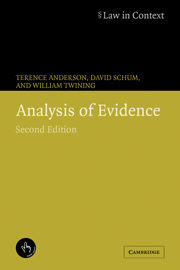Book contents
- Frontmatter
- Contents
- Preface
- Acknowledgments
- Tables of cases and statutes
- Table of legislation and rules
- List of abbreviations
- 1 Evidence and inference: some food for thought
- 2 Fact investigation and the nature of evidence
- 3 Principles of proof
- 4 Methods of analysis
- 5 The chart method
- 6 Outlines, chronologies, and narrative
- 7 Analyzing the decided case: anatomy of a cause célèbre
- 8 Evaluating evidence
- 9 Probabilities, weight, and probative force
- 10 Necessary but dangerous: generalizations and stories in argumentation about facts
- 11 The principles of proof and the law of evidence
- 12 The trial lawyer's standpoint
- Glossary of terms and symbols
- References
- Index
12 - The trial lawyer's standpoint
Published online by Cambridge University Press: 23 November 2009
- Frontmatter
- Contents
- Preface
- Acknowledgments
- Tables of cases and statutes
- Table of legislation and rules
- List of abbreviations
- 1 Evidence and inference: some food for thought
- 2 Fact investigation and the nature of evidence
- 3 Principles of proof
- 4 Methods of analysis
- 5 The chart method
- 6 Outlines, chronologies, and narrative
- 7 Analyzing the decided case: anatomy of a cause célèbre
- 8 Evaluating evidence
- 9 Probabilities, weight, and probative force
- 10 Necessary but dangerous: generalizations and stories in argumentation about facts
- 11 The principles of proof and the law of evidence
- 12 The trial lawyer's standpoint
- Glossary of terms and symbols
- References
- Index
Summary
A Wigmorean lawyer prepares for trial
The purpose of this part of the chapter is twofold. First, we want to set Wigmorean analysis in general and the chart method in particular in the context of trial preparation and practice in the United States. All competent lawyers use and apply the principles of proof in preparing a case and all use one or more devices to consolidate the results of their analysis. The chart method is simply an additional and a more methodical and rigorous device, one that requires making explicit what might otherwise be left implicit. Second, we want to describe the processes and devices lawyers commonly use to translate and reorganize the products of their analysis of the law and facts into a form suitable for use at trial. We start by describing some such devices and conclude with a brief discussion of ways in which the products of analysis are translated into the tools of advocacy.
Of charts and other analytic devices
All phases of the trial lawyer's work involve two fundamental and related processes: analysis of law and analysis of fact. At all points from the initial interview onward, the lawyer uses her existing legal knowledge to probe for facts that may be relevant to the case at hand. These facts in turn suggest further inquiries: the potentially applicable legal principles may be expanded, narrowed, or refined by research and analysis. The facts known and the products of the legal research and analysis may suggest additional lines of factual inquiry.
- Type
- Chapter
- Information
- Analysis of Evidence , pp. 315 - 378Publisher: Cambridge University PressPrint publication year: 2005



